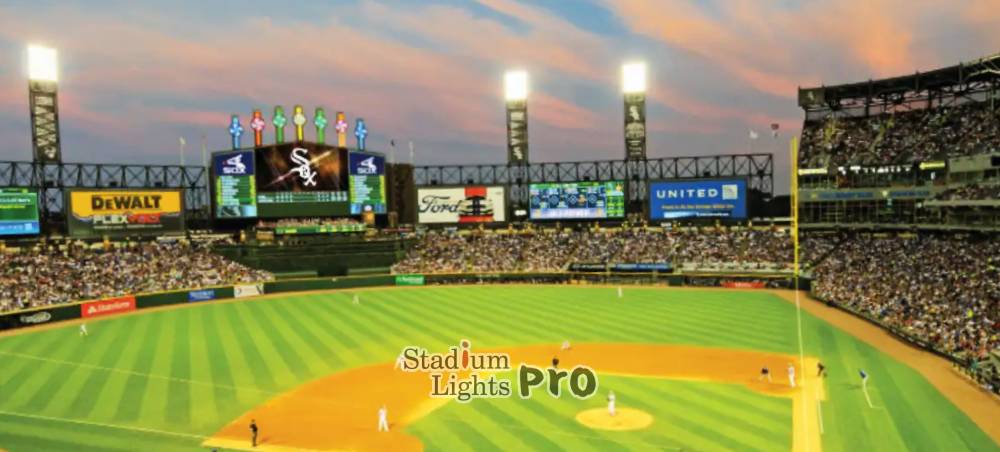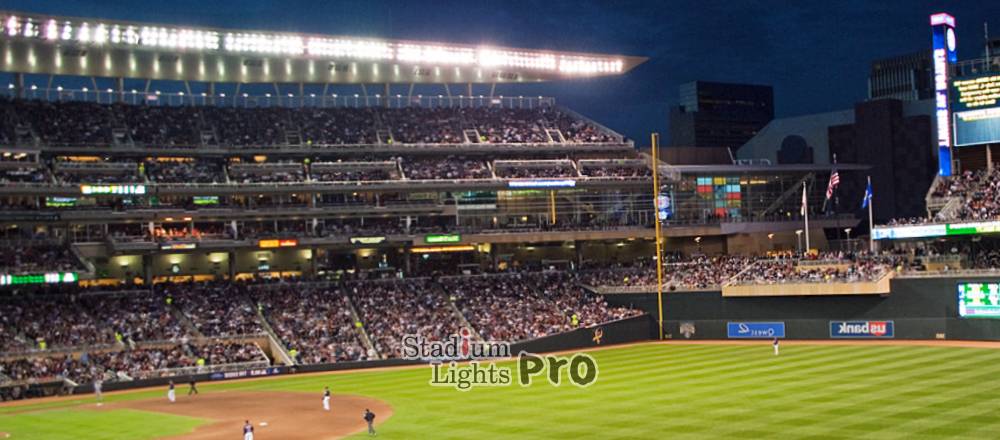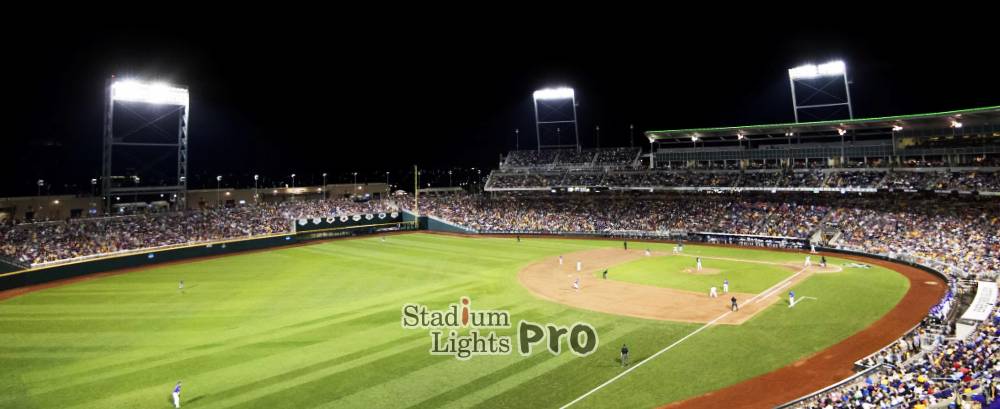Metal halide lights are a type of high-intensity discharge (HID) lamp that is widely used for outdoor lighting, particularly in large venues such as sports stadiums, parking lots, and street lighting. These lights are known for their ability to produce a bright, white light with high color accuracy and intensity. Metal halide lamps use a combination of metal salts and mercury vapor to produce light when electricity passes through the gas mixture inside the lamp.
| Feature | Value/Number |
|---|---|
| Typical Lifespan of Metal Halide Bulbs | 10,000 to 15,000 hours |
| Color Temperature Range | 3,000K to 5,500K |
| Wattage Range of Metal Halide Lamps | 50W to 1,000W or more |
| Maximum Temperature in Arc Tube | Up to 1,000°C |
| Lamp Lumen Output | Varies by wattage (higher wattage = higher lumen output) |
| Warm-Up Time to Full Brightness | Few minutes (typically 2-5 minutes) |
| Color Temperature for Warm White | ~3,000K |
| Color Temperature for Daylight | ~5,500K |
| Typical Wattage for Sports Stadiums | 400W, 1,000W or more |
| Lumen Depreciation | Gradual decrease over time (bulb replacement needed every few years) |
| Metal Halide Lamp Wattage in Baseball Stadiums | 400W, 1,000W or higher, depending on the venue size |
Table of Contents
ToggleHow Metal Halide Lights Work
Metal halide lights operate on the principle of high-intensity discharge (HID), where light is generated by an electrical arc passing through a mixture of gases and metals. The working mechanism of metal halide lights involves an electrical current that passes through a pair of electrodes placed inside the bulb. The current causes the mercury inside the bulb to vaporize, and as the vaporized mercury interacts with the metal salts, it excites them. This process results in the emission of light. The combination of mercury vapor and various metal salts (such as iodine, bromine, and thallium) creates a light spectrum that closely resembles natural sunlight.

Arc Discharge Process
The core component of a metal halide lamp is the arc tube, which contains a mixture of mercury and metal halides. When the electrical current is passed through the lamp, it creates an electrical arc between two electrodes inside the tube. This arc vaporizes the mercury and excites the metal salts, resulting in light emission. The electrical arc provides the energy required for this chemical reaction, and it generates high temperatures that allow the mercury to ionize and the salts to emit visible light.
High-Intensity Light Production
The arc tube’s design allows for the efficient release of light. When the lamp is operating, it generates high-intensity light with high luminous efficacy—meaning more light is produced for less energy input. This high intensity is one of the primary reasons why metal halide lamps are chosen for large-scale outdoor applications like stadiums, parking lots, and sports arenas, where illumination over a large area is necessary.
Brightness and Color Rendering
One of the most notable features of metal halide lights is their ability to deliver a very bright output. The intense light generated by the arc discharge can illuminate a vast area, making metal halide lights ideal for environments where brightness is important. Additionally, the specific wavelengths of light emitted by metal halide lamps provide excellent color rendering. This characteristic is particularly beneficial in applications where accurate color reproduction is crucial, such as sports stadiums, where players and spectators need to see fine details clearly.
Color Temperature and Light Quality
The color temperature of a light source refers to the warmth or coolness of the light emitted, which is measured in Kelvin (K). Metal halide lights are known for their ability to produce a bright, clean light with a color temperature that closely resembles natural daylight. This characteristic makes them a popular choice in situations where visual clarity and accurate color representation are needed.
Range of Color Temperatures
Metal halide lights typically produce a color temperature between 3,000K and 5,500K. This range places them in the category of lights that produce a cool white or daylight-like glow. The 3,000K color temperature is closer to warm white light, often used in indoor settings, while the 5,500K temperature is closer to pure daylight, ideal for outdoor applications. This range of color temperature makes metal halide lamps versatile for various applications, from providing a warmer, more inviting atmosphere to creating an intense, daylight-like effect for large-scale sporting events.
Advantages Over Other HID Lamps
Compared to other types of high-intensity discharge lamps, such as high-pressure sodium (HPS) lights, metal halide lights offer superior color rendering. High-pressure sodium lamps, for example, emit a yellowish-orange light that distorts colors, making them less suitable for applications that require accurate color reproduction. Metal halide lights, on the other hand, emit a whiter, more neutral light that better replicates natural daylight and provides a more natural visual experience.
This characteristic is especially significant in sports environments, where visibility and accurate color rendering are critical for players and spectators alike. Whether it’s a baseball field, football stadium, or a basketball court, metal halide lamps help to create an environment where players can track the ball or other fast-moving objects more easily, and spectators can clearly distinguish players’ uniforms and details of the action.

Types of Metal Halide Lights
Metal halide lights are available in several different configurations, each designed for different applications. These configurations vary in terms of their bulb structure, wattage, and how they are used in different settings. The most common types of metal halide lamps are open-rated and enclosed-rated bulbs.
Open-Rated Metal Halide Lamps
Open-rated metal halide lamps are designed to be used in environments where the bulb is exposed to air. These lamps are often used in settings where the bulb will be installed in a fixture that does not completely enclose the lamp. The open-rated design allows the bulb to be exposed to air, which helps to maintain efficient heat dissipation during operation. However, this design also means that these lamps are more susceptible to damage from external factors such as moisture, dust, or physical impact.
Open-rated bulbs are commonly used in large outdoor fixtures, such as streetlights and high-mast lighting systems in parking lots or stadiums, where the fixture is designed to protect the lamp to some extent from environmental factors. In these types of installations, the lamp is often placed in a reflective housing or an open frame fixture that allows air circulation and cooling.
Enclosed-Rated Metal Halide Lamps
Enclosed-rated metal halide lamps, on the other hand, are specifically designed to be used in fixtures that fully enclose the bulb. These fixtures protect the lamp from external elements like dust, moisture, and even direct contact with air. Enclosed-rated bulbs are typically used in environments where the lamp needs additional protection, such as in industrial or commercial spaces, or in areas with high humidity or frequent exposure to the elements. Enclosed-rated lamps are often used in large-scale indoor lighting applications like stadiums, arenas, or warehouses, where additional protection against environmental factors is required to maintain the longevity of the lamps.
Wattage Variations and Light Output
Another important factor in the selection of metal halide lamps is the wattage. Metal halide lamps are available in a range of wattages, from smaller, more compact models around 50 watts to large lamps that exceed 1,000 watts. The wattage of the bulb determines its light output, which is measured in lumens. A higher wattage bulb will produce a higher lumen output, making it suitable for larger spaces that require more illumination.
The wattage is a critical consideration in selecting the appropriate metal halide light for a particular application. For example, sports stadiums and large arenas may require lamps with higher wattages (e.g., 400 watts, 1,000 watts, or more) to provide the necessary brightness and light coverage. In contrast, smaller commercial or residential applications may use lower-wattage lamps that still provide adequate lighting while minimizing energy consumption.
Lamp Longevity and Maintenance Considerations
While metal halide lights are known for their excellent light quality, they do require more maintenance and have a shorter lifespan compared to other lighting technologies like LEDs. The typical lifespan of a metal halide bulb ranges between 10,000 to 15,000 hours, depending on usage and environmental factors. Over time, metal halide lamps can experience a reduction in light output, known as lumen depreciation, which means that they will not be as bright as they were when initially installed.
To maintain optimal lighting conditions, metal halide lamps often need to be replaced every few years, depending on usage. This is one of the factors that make them less appealing in certain applications where long-term cost savings and reduced maintenance are a priority. As such, LED lights have become a popular alternative due to their longer lifespan and lower maintenance requirements. However, metal halide lamps continue to be a preferred option in settings where their superior color rendering and brightness are essential.

Differences Between Metal Halide Lights and Other Types of Lighting
When comparing metal halide lights to other types of lighting, it’s important to consider various factors such as design, usage, and cost. These factors can help determine which lighting technology is best suited for a particular application.
Design of Metal Halide Lights Versus Other Lights
The design of metal halide lights is quite distinct from other lighting technologies, primarily due to the materials used and the way light is produced. Metal halide lamps have a more complex structure than traditional incandescent or fluorescent lights. The arc tube inside the bulb, which contains the metal salts and mercury, is typically surrounded by a protective glass envelope. This design ensures the safe containment of gases that can become very hot during operation.
In contrast, other lighting types, such as LEDs and fluorescent lights, have a simpler design. LEDs, for instance, use semiconductors to produce light, which is a much more energy-efficient process than the arc discharge used in metal halide lamps. Fluorescent lights, on the other hand, rely on a gas-filled tube and phosphor coating to generate light, which is quite different from the high-intensity discharge process found in metal halide lights.
The physical design of metal halide lamps also means that they can be more susceptible to damage from vibration and shocks, especially in outdoor environments where they are exposed to the elements. LEDs, by comparison, are more durable and less prone to breakage due to their solid-state design.
Usage of Metal Halide Lights Versus Other Lights
The primary usage of metal halide lights is in applications where high-intensity lighting is required. This includes sports stadiums, large arenas, parking lots, and even street lighting in urban areas. Metal halide lamps are often chosen for these applications because of their ability to provide bright, high-quality light with excellent color rendering.
In comparison, LED lights are becoming increasingly popular for outdoor lighting because of their energy efficiency, longer lifespan, and lower maintenance costs. LEDs are commonly used for street lighting, parking lots, and even in some sports stadiums. However, LED lights generally offer a cooler light color, which may not always be ideal for applications requiring warmer lighting, such as those found in certain sports settings.
Incandescent and halogen lights are another alternative, but they are far less energy-efficient than both metal halide and LED lights. These types of lighting are mostly used in residential settings or small-scale applications and are not typically used for large-scale outdoor lighting due to their relatively low efficiency and brightness.
Cost of Metal Halide Lights Versus Other Lights
One of the key factors in choosing between metal halide lights and other types of lighting is the cost. Metal halide lights tend to have a higher upfront cost compared to incandescent or halogen lamps. However, they are generally more affordable than LED lights, which can be more expensive due to the advanced technology used in their production.
In terms of operational costs, metal halide lights can be more expensive than LEDs because of their higher energy consumption. Metal halide lamps require a considerable amount of energy to operate and may need to be replaced more frequently than LEDs, which have a longer lifespan. Additionally, the maintenance costs for metal halide lights can be higher due to the need to replace bulbs and other components more often.
LED lights, while more expensive upfront, offer much lower operational and maintenance costs over time due to their energy efficiency and longevity. As a result, many sports venues and large commercial facilities are transitioning to LED lighting to reduce long-term expenses, although metal halide lights remain a common choice for certain applications where the lighting quality is a priority.
Why the Design of Metal Halide Lights Is Like This
The design of metal halide lights has been shaped by the need to achieve high light output while maintaining durability and safety. The most prominent feature of these lamps is the arc tube, which contains a mixture of mercury vapor and metal salts. The arc tube is surrounded by a protective outer shell made of glass or quartz, which helps to contain the hot gases and prevent them from escaping.
Durability and Heat Resistance
The arc tube is typically made of a durable material that can withstand the high temperatures generated during operation. These lamps can generate temperatures of up to 1,000 degrees Celsius, which is why the materials used in the design must be heat-resistant and capable of withstanding extreme conditions. The design of the lamp also allows for efficient heat dissipation, which is essential to ensure the longevity of the lamp and maintain its performance over time.
Producing High-Quality Light Output
Another reason for the specific design of metal halide lamps is the need for a high-quality light output. The combination of mercury vapor and metal salts produces a spectrum of light that closely resembles natural sunlight, which is why these lamps are often used in outdoor settings where color rendering and visibility are crucial. The precise balance of gases and materials in the lamp helps to achieve this effect, making the design of the lamp a critical factor in its functionality.
Warm-Up Time and Control
The lamp’s design also allows for relatively quick warm-up times, although it does take a few minutes for the light to reach full brightness. This feature is beneficial in applications like sports stadiums, where lighting must be ramped up quickly for events and can be easily controlled via lighting systems.
Why Use Metal Halide Lights in Baseball Stadiums?
Baseball stadiums require high levels of lighting to ensure that players, coaches, and spectators can see the action clearly. Metal halide lights are often the preferred choice for stadiums due to their high light output and color-rendering capabilities. Baseball games, like many other sports, are played outdoors, which means that the lighting must be able to replicate natural daylight as closely as possible. Metal halide lamps offer a color temperature that is closer to natural sunlight compared to other lighting types, making them ideal for outdoor sporting venues.
Brightness and Light Uniformity
The design of metal halide lamps allows them to produce a uniform light distribution over a large area, which is crucial for a baseball field. These lights are capable of illuminating the entire playing surface evenly, minimizing shadows and creating a more consistent visual environment for players and spectators. This is especially important for a sport like baseball, where accurate vision of the ball is essential for both players and fans.
Lumen Output for Night Games
Additionally, metal halide lights are capable of producing a high lumen output, which is a measure of the total amount of visible light emitted by the lamp. This high lumen output ensures that the field is brightly illuminated, even during night games when natural daylight is unavailable. The intensity of the light generated by metal halide lamps is especially important in large outdoor settings, where a considerable amount of light is needed to illuminate expansive areas such as sports fields. The strong and consistent illumination provided by these lights helps to create the ideal lighting conditions for baseball games, allowing for clear visibility of both the playing field and the players themselves.
The ability to generate such bright and intense light allows baseball games to be played under optimal lighting conditions, ensuring that the ball is easily visible to both players and spectators. This level of lighting is particularly important in fast-paced sports like baseball, where quick reactions and precise movements are required. For players, the enhanced visibility allows them to track the ball more effectively, whether it’s a fast pitch, a high fly ball, or a long hit. For fans, the bright, clear light enhances the viewing experience, ensuring that they can see all the action without strain, even during evening or night games.
Moreover, the intense brightness produced by metal halide lights also helps to minimize shadows on the field, ensuring that no part of the playing surface is left dimly lit. This uniform lighting distribution is key in creating a well-lit environment for both the players and the audience. The bright, even lighting ensures that no area of the field is underlit, which can often lead to distractions or missed plays. Whether it’s during the early evening or the late hours of the night, the high lumen output of metal halide lights makes it possible to maintain top-tier visibility throughout the game, improving the overall experience for everyone involved.
Durability for Outdoor Conditions
Another factor that makes metal halide lights particularly suitable for baseball stadiums is their ability to withstand the wear and tear of outdoor environments. Stadiums, by their nature, are exposed to a wide range of weather conditions, including heavy rain, high winds, and fluctuating temperatures. These environmental challenges can put significant stress on outdoor lighting systems, but the robust design of metal halide lamps allows them to continue operating effectively, even under these demanding conditions.
The construction of metal halide lamps typically includes durable materials that are resistant to weathering and physical impact. The arc tube, which contains the mixture of gases and metal salts, is made from tough materials like quartz or ceramic, allowing it to endure the high temperatures and environmental exposure. Additionally, the outer glass envelope or protective casing of the lamp is designed to be resistant to moisture, dust, and debris, which can often accumulate in outdoor environments.
Metal halide lights are designed to perform reliably in a wide range of temperatures, making them capable of functioning well in both hot and cold conditions. Whether a stadium is located in a region with extreme summer heat or in an area with harsh winter weather, the lamps’ design ensures that they can continue to provide consistent illumination, regardless of external temperature fluctuations. This resilience is particularly important in regions where weather conditions can change rapidly, such as during spring or autumn seasons when rain and wind are common, yet games still need to go on.
Moreover, the strong construction of metal halide lights reduces the risk of premature failure due to environmental stress. While other lighting technologies may be more prone to malfunction when exposed to these extreme conditions, metal halide lamps have been designed to handle such challenges, making them a dependable option for stadiums that need continuous performance over long periods. The combination of durability, weather resistance, and high-performance capability ensures that baseball games can be held under optimal lighting, even when the weather is unpredictable. This robust performance makes metal halide lights an ideal choice for stadiums that host both day and night games, regardless of the changing weather patterns.
Flexibility in Lighting Control
In many baseball stadiums, metal halide lights are used in combination with advanced lighting control systems to provide greater flexibility in managing light output. These sophisticated control systems allow stadium operators to adjust the intensity of the lighting, dimming or brightening the lights as needed to meet specific requirements for different game scenarios or events. This ability to finely control the light levels provides several advantages, especially in terms of energy efficiency and the quality of the lighting experience.
By integrating dimming capabilities, stadiums can optimize their energy usage, reducing power consumption when full brightness is not required. For example, during warm-ups or in between innings when the players are not on the field, the lighting can be dimmed to a lower level, conserving electricity without compromising visibility for the audience or players. This feature also allows for tailored lighting based on specific game needs. For example, certain sections of the stadium, such as the dugouts or the outfield, might require slightly different lighting setups depending on where the action is taking place. Advanced control systems make it possible to adjust the intensity in specific areas of the field to provide the optimal visual experience, ensuring that no part of the game goes under-illuminated.
Additionally, the ability to adjust lighting intensity dynamically during the game adds to the overall ambiance and atmosphere of the event. For instance, the lights can be brightened before a key moment, such as a home run or a game-winning play, to increase the dramatic effect for both players and fans. This control over light intensity also allows for smooth transitions, ensuring that lighting changes are seamless and do not disrupt the game flow. The system can be pre-programmed or manually adjusted to meet the lighting needs of each specific event, whether it’s a regular season game, a playoff game, or a special evening event with a spotlight on a particular player.
From an operational standpoint, advanced lighting control systems help to minimize wear and tear on the metal halide lamps themselves. By reducing the frequency of full intensity lighting and controlling the ramp-up and ramp-down processes, the lamps’ lifespan can be extended, as they are not operating at maximum output all the time. This reduces the need for frequent bulb replacements and lowers maintenance costs over the long term.
Furthermore, these control systems can be integrated with other stadium infrastructure, such as video boards or sound systems, to synchronize lighting with other elements of the game experience. For example, lighting can be coordinated with the start of a broadcast, pre-game introductions, or special moments during the game, helping to create a visually cohesive and engaging experience for the fans in the stadium and those watching at home.
Overall, the combination of metal halide lights and advanced lighting control systems provides a balanced approach to energy efficiency, cost-effectiveness, and optimal lighting quality. The ability to adjust light intensity as needed ensures that baseball stadiums can maintain ideal playing conditions while also reducing their environmental impact and operational costs.
Conclusion
Metal halide lights continue to be a popular choice for large-scale outdoor lighting applications, particularly in environments like sports stadiums, parking lots, and street lighting, due to their high light output, excellent color rendering, and durability. Their ability to closely mimic natural daylight and provide superior illumination makes them ideal for events that require clear visibility and color accuracy, such as sports games.
Despite their relatively higher energy consumption and maintenance requirements compared to newer technologies like LEDs, metal halide lamps are still favored in settings where brightness, color quality, and performance under varying environmental conditions are essential. Their robust design ensures that they can withstand the harsh outdoor conditions found in many sports stadiums and arenas, and their flexibility in lighting control adds a layer of operational efficiency.
As technology continues to evolve, alternatives like LED lighting are becoming increasingly prevalent due to their energy efficiency and longer lifespan. However, for applications where light quality and intensity are paramount, particularly in large venues, metal halide lights remain a reliable and effective solution. They provide the high luminous efficacy required for optimal performance in challenging environments, ensuring that both players and spectators enjoy a clear, vivid experience under the lights.

